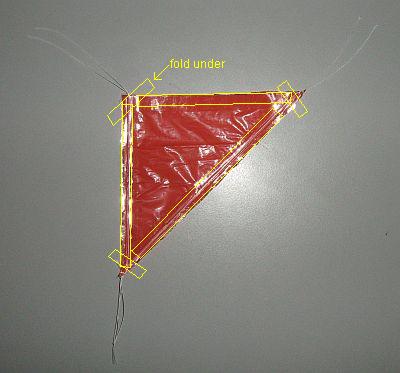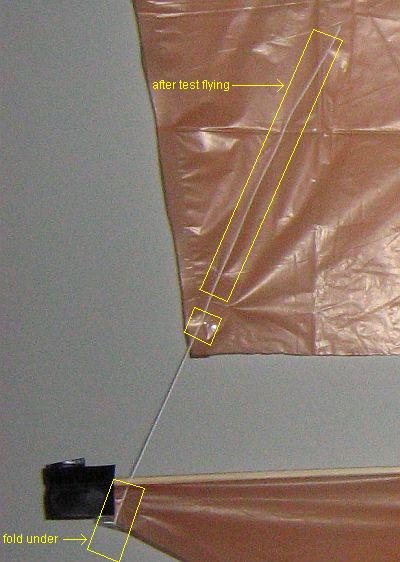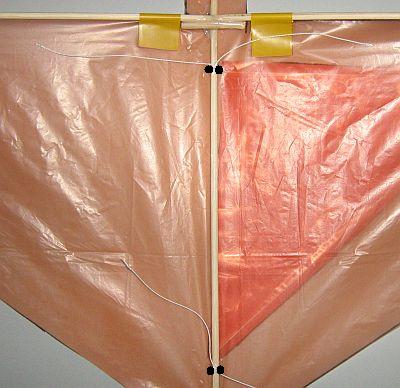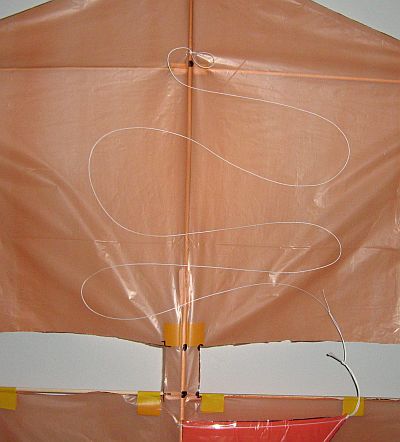- Home Page
- Better Kites
- ... Roller Kite
How to Build a Roller Kite
Step-by-Step—Page 2 of 3
The MBK 2-Skewer Roller
How to Build a Roller Kite
Keel
Dacron line in 20 to 50-pound strength is suitable for all the Skewer Series kites.

In this photo, pieces of clear sticky tape are indicated by yellow rectangles.
- Mark out a triangle on some spare sail plastic, as per the dimensions on the template.
- Cut off four pieces of flying line, each about 1.25 SL (36 cm, 14 in.) long.
- Cut out the triangle and tape down two lengths of flying line onto one side, as visible in the photo.
- Now flip the plastic over and tape down another two lengths of flying line, directly over the first two.
- Also lay down tape along the remaining edge of the keel, on both sides of the plastic.
- Reinforce the keel by sticking down and wrapping extra bits of tape where the pieces of line come out, making sure the plastic remains flat.
- Where the four pieces of line come together, tie a Multi-Strand Simple knot close to the plastic, then tie another one further out, as in the photo.
- Also tie Simple knots close to the plastic at the other two corners.
How to Build a Roller Kite
Sail Tethering

At this point you need to make sure the glue is dry on the frame. If it is:
- Lay down the kite with the bamboo on top, and cut two short lengths of flying line—about 0.75 SL (22 cm, 9 in.) each.
- First, tape the lines to the lower sail near the tips; go over the bamboo, around the sail edge and then back toward the bamboo. See the yellow rectangle in the photo.
- Lay the lines across the upper sail and tape them down with just a small piece of tape near the sail corner.
- Carefully pull each line through the tape until there is no slack—as in the photo.
During test flying, it might be necessary to slacken off one of these lines to get the kite to fly straight. Once you are happy with the trim, you should add more tape to make sure the line never slips during flight. It should still be possible to pull a little line through by hand though.
How to Build a Roller Kite
Bridle

Firstly, attach the keel:
- Poke two holes in the lower sail, near the lower horizontal spar, where indicated by the black dots near the top of the photo.
- Take the keel and poke the upper two lines through the holes near the horizontal spar. Then pull tight against the knot, and tie them off around the bamboo using a Granny knot.
- Now poke the bottom two holes in the plastic, using the keel to find the exact spots for the holes.
- Thread the lines, pull tight against the knots, and tie them off tightly around the bamboo, using a Granny knot.
These knots must never come loose, so use tiny drops of glue to keep them secure.

Next, attach the bridle:
- Lay the kite down with the keel on top, then cut a length of flying line, about 5.0 SL (145 cm, 58 in.) long.
- Tie a small Loop knot into each end of the line.
- Poke two holes in the upper sail where indicated by black dots in the photo.
- Attach one end to the vertical spar through the two holes in the upper sail. Use a Double Wrap Slip knot and pull tight. Then secure with a tiny dob of glue.
- Attach the other end to the keel using a Larks Head knot, and pull tight against the keel's big knot.
Finally, take a length of flying line about 0.5 SL (15 cm, 6 in.) long, and tie one end to the bridle line with a shiftable knot such as the Prusik. Tie a small Loop knot into the other end.
At this point, you've pretty much finished making the 2-Skewer Roller!
As mentioned earlier, there's more kite making on this site than you can poke a stick at :-)
Want to know the most convenient way of using it all?
The Big MBK E-book Bundle is a collection of downloads — printable PDF files which provide step-by-step instructions for many kites large and small.
Every kite in every MBK series.
